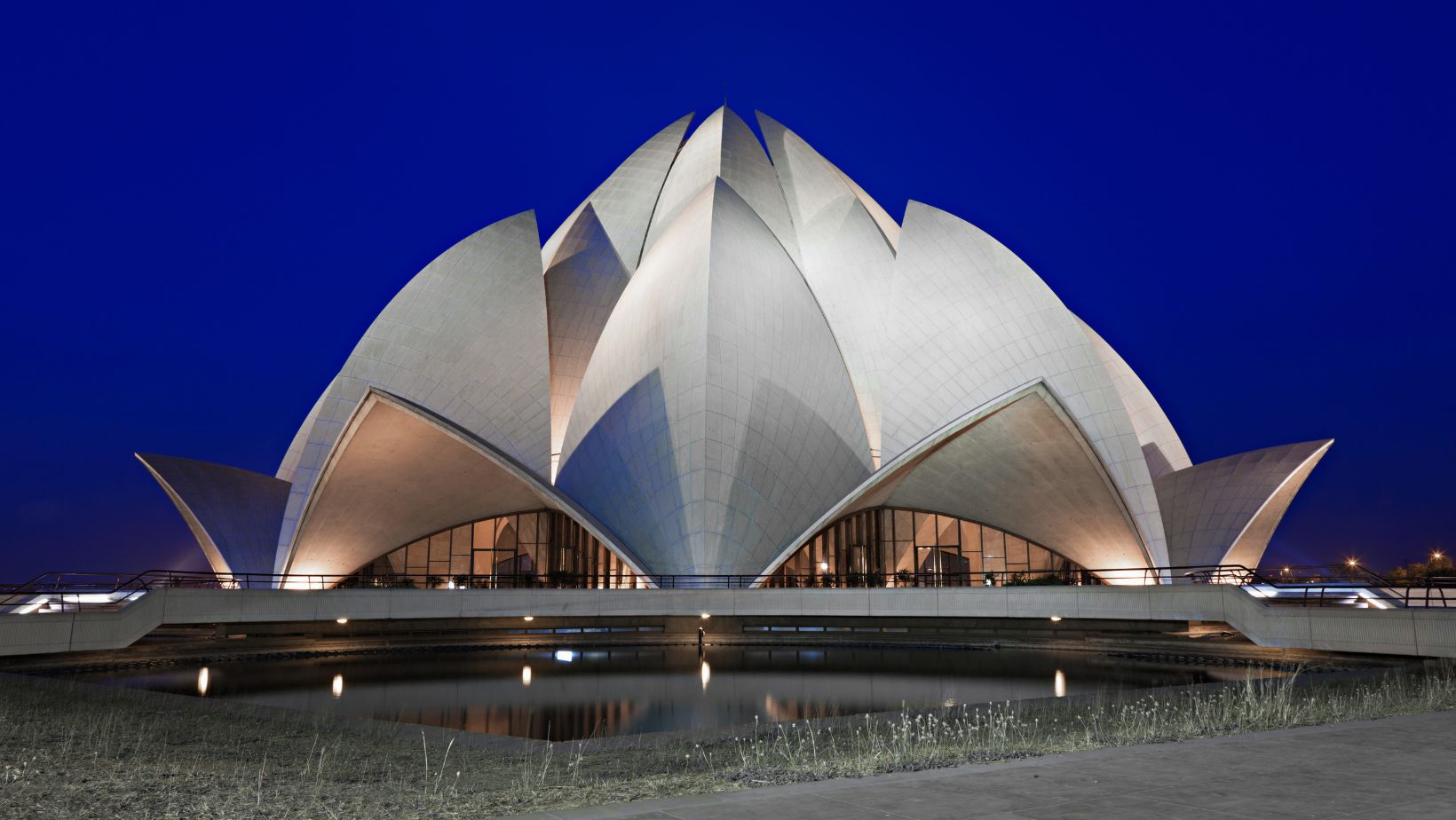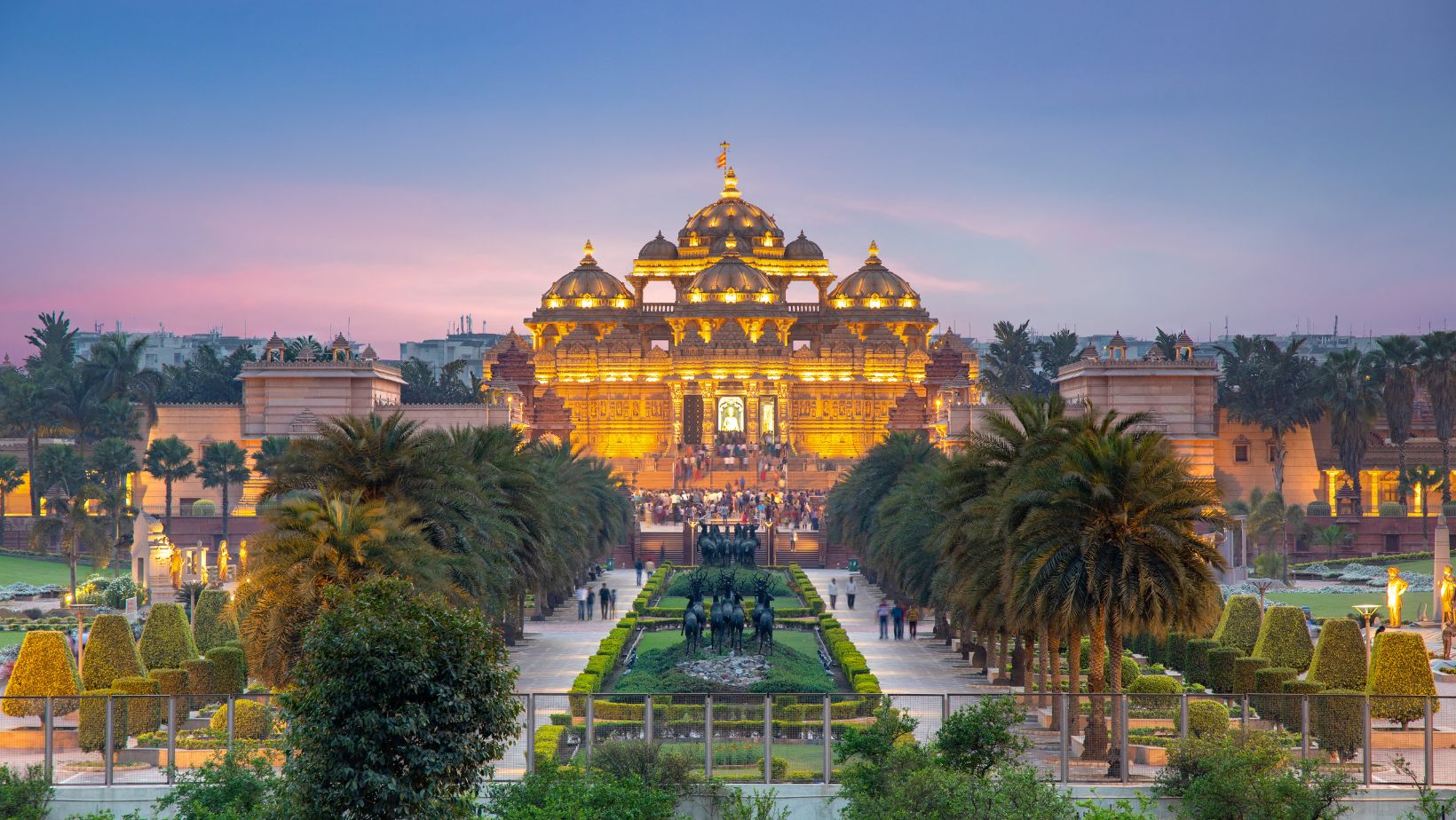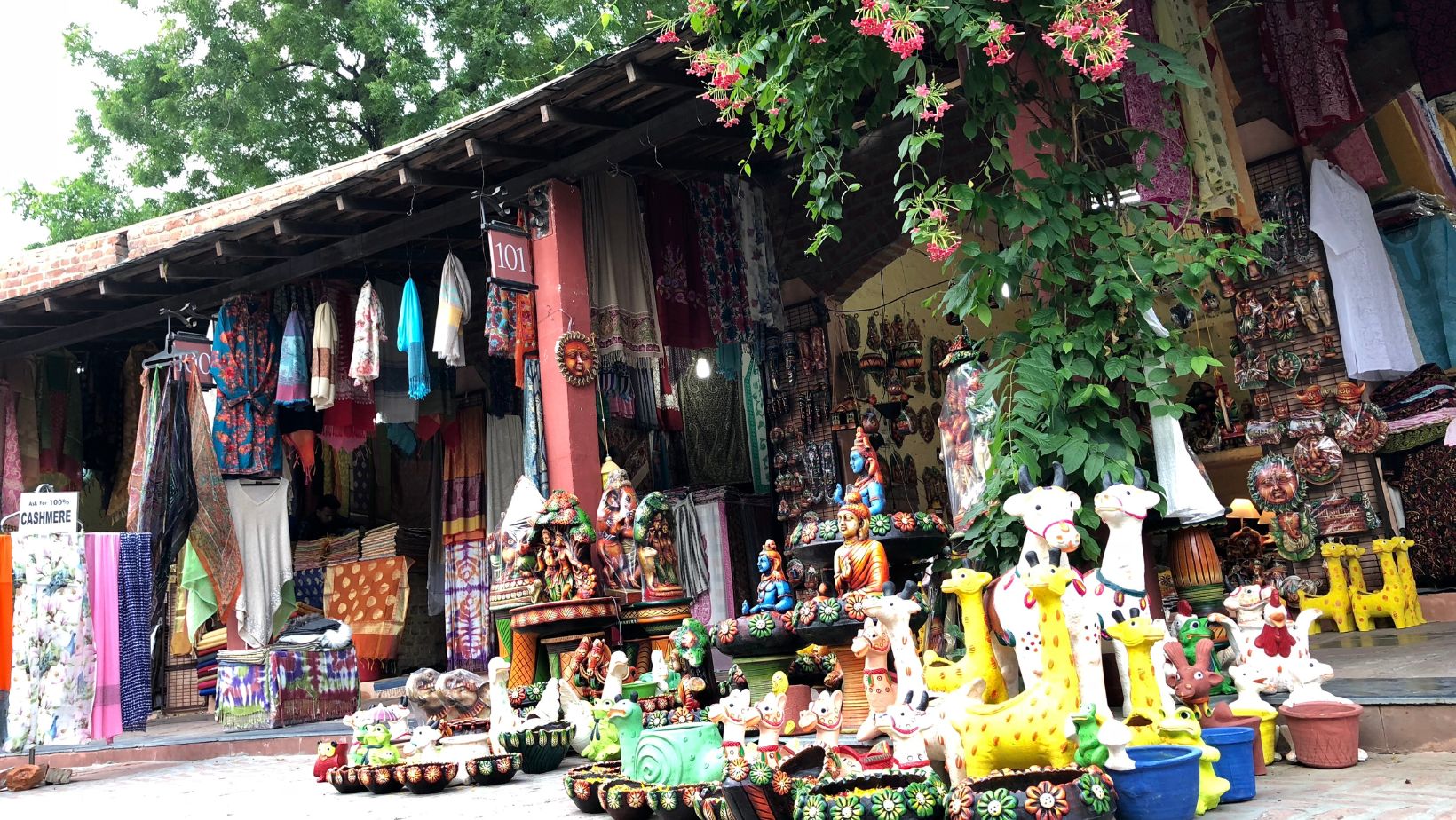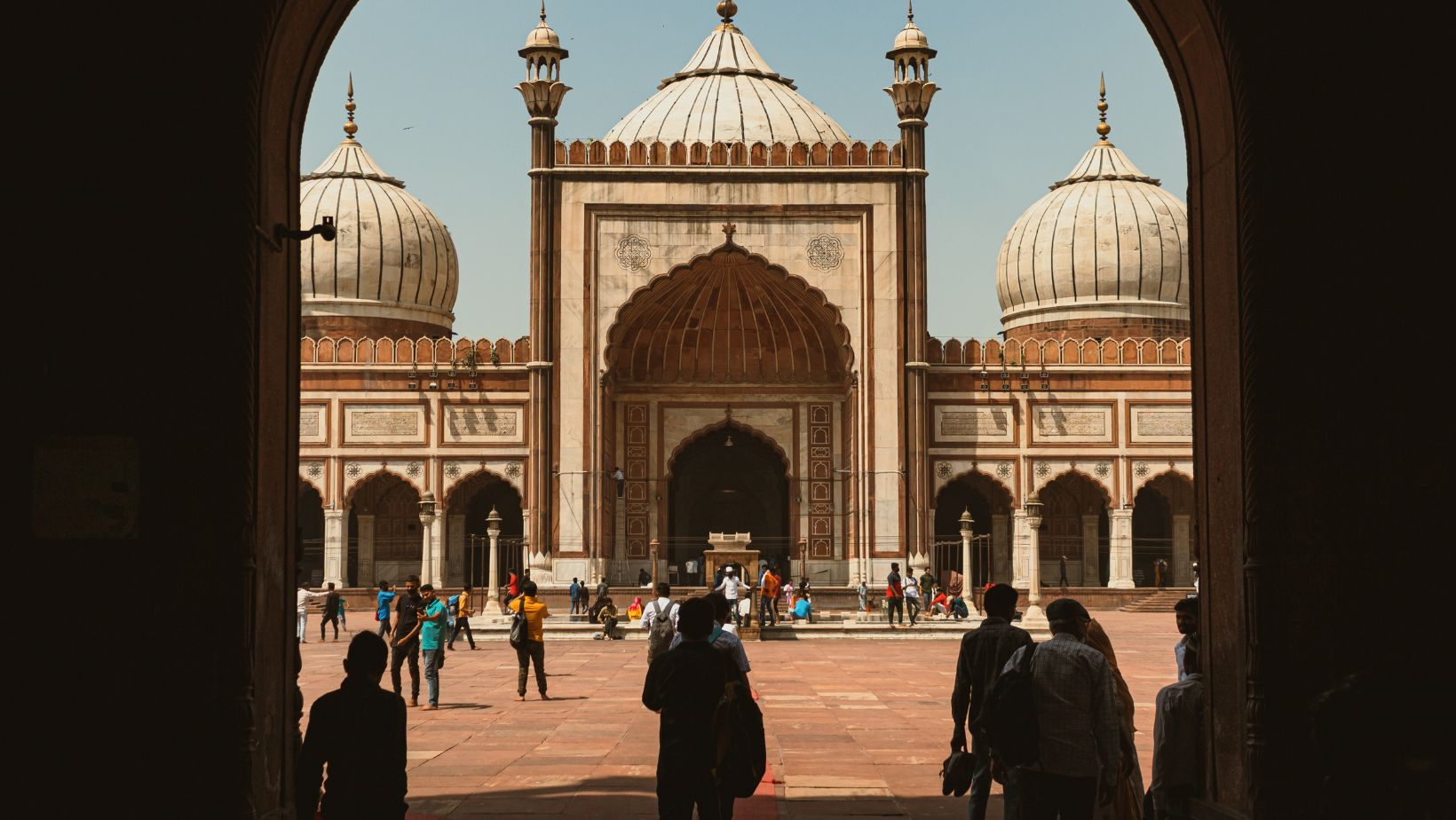New Delhi, the capital city of India, boasts numerous historical and cultural landmarks that may captivate Thai tourists and expats with their ties to Buddhism and shared cultural legacy. Although Thai temples are not present in New Delhi, some destinations exhibit India’s rich cultural and religious tapestry, offering a glimpse into Buddhism and other ancient customs. Below are a few noteworthy sites in New Delhi:
1. Lotus Temple: The Lotus Temple, also known as the Bahāʾī Faith house of worship or mashriq al-adhkār, is located in New Delhi. This architectural marvel is referred to as a mashriq, which signifies a place where the name of God is uttered at dawn. As of the early 21st century, there were only nine such mashriqs in existence worldwide.

The consecration of the Lotus Temple took place in December 1986, marking its official opening to the public. The visionary Iranian architect, Fariborz Sahba, was responsible for its remarkable design, which garnered widespread acclaim even before its construction was finished. Over time, the temple has been bestowed with multiple accolades, further highlighting its architectural excellence.
The design of the Lotus Temple is the reason behind its name. Similar to other Bahāʾī mashriqs, it features a nine-sided structure, reflecting the Bahāʾī belief in the mystical significance of the number nine. Situated on an elevated platform within a 26-acre (10.5-hectare) expanse of beautifully landscaped gardens, the temple is encompassed by nine pools bordered by red sandstone walkways. The white marble building stands tall at a height exceeding 130 feet (40 meters). The temple complex consists of 27 separate marble “petals” that are arranged in groups of three to form nine sides, each side leading to one of the nine entrances into the central space. These petals are further grouped into sets of nine to create three concentric rings. The petals in the first ring face outward, creating canopies over the nine entrances. The second ring covers the outer hall, while the petals in the innermost ring curve inward, partially enclosing the central prayer hall that can accommodate approximately 2,500 individuals. Although the top of the structure appears open, it actually features a glass-and-steel roof that allows natural daylight to enter. The overall impression is that of a floating lotus flower, poised to bloom, and surrounded by its leaves.
2. Akshardham Temple: The term ‘Akshardham’ signifies the divine dwelling place of God. It is renowned as a perpetual sanctuary of devotion, purity, and tranquility. Swaminarayan Akshardham in New Delhi is a Mandir, a sacred abode of God, a Hindu place of worship, and a spiritual and cultural campus devoted to devotion, education, and unity. Its artwork and architecture beautifully reflect timeless Hindu spiritual teachings, vibrant devotional customs, and ancient architectural styles. This mandir serves as a humble homage to Bhagwan Swaminarayan (1781-1830), the avatars, deities, and revered sages of Hinduism. Inaugurated on 6 November 2005, this traditionally-designed complex was brought to life through the dedicated efforts of skilled artisans and volunteers, under the blessings of HH Pramukh Swami Maharaj.

The spiritual energy of Akshardham is palpable in every aspect of the complex, from the Mandir’s stunning collection of over two hundred murtis to the tranquil beauty of the Gardens. At the heart of Akshardham’s philosophy is the belief that every soul has the potential for divinity, and that every act of service, no matter how humble, can bring one closer to this goal. A visit to Akshardham is an opportunity to deepen one’s understanding of prayer, non-violence, and the universal principles of Hinduism, and to experience the beauty of God’s abode on Earth.
3. Dilli Haat: Dilli Haat, established jointly by Delhi Tourism (DTDC), Government of Delhi, and NDMC, D.C. (Handicrafts) & D.C. (handlooms), Ministry of Textiles & Ministry of Tourism, Govt. of India, was made accessible to the public in March 1994. Within a span of approximately nine years, by 2003, this market transformed into a thriving destination for food enthusiasts and avid shoppers, thanks to its unique handcrafted products, diverse clothing range, and delectable cuisine. Additionally, it introduced wheelchair accessibility and restroom facilities. Subsequently, in 2008, another branch was inaugurated in Pitampura, covering an area of 7.2 hectares. Not long after, in July 2014, another Dilli Haat was opened in Janakpuri. Over time, this market has evolved into a vibrant cultural hub, and more recently, it has become the venue for Delhi’s most enjoyable festival, the Comic-Con, held at the INA branch.

Dilli Haat showcases the traditional architectural style of northern India, featuring brick latticework and stone roofs. Within the complex, there is a spacious hall that hosts exhibitions and showcases handlooms and handicrafts. Additionally, this venue occasionally hosts cultural events such as folk dances and drama. To cater to tourists, there is a small souvenir shop offering a variety of Delhi-themed souvenirs.
Day out at Dilli Haat:
- Dilli Haat showcases the magnificent Tanjore paintings, originating from Tamil Nadu, which are adorned with gold foil for a touch of opulence.
- The renowned Madhubani paintings, with their ancient roots in Bihar, can also be found here.
- Orissa’s chic metalware, including tastefully crafted brass and copper junk jewelry, is a must-have at the market.
- Dilli Haat offers an extensive range of leather products, featuring a variety of tans, styles, totes, bags, belts, and wallets that are sure to captivate you.
- Indulge in exquisite Lucknowi chikankari suits and stunning Punjabi phulkari dupattas to satisfy your shopping desires.
- Explore the home decor section for an array of beautifully engraved furniture, brass wares, vintage-style antiques, and storage units.
- Lastly, don’t miss out on the delectable gourmet food stalls at Dilli Haat, offering a diverse range of cuisines from Mughlai biryani to Sikkimese thukpa and Gujarati thepla.
Food at Dilli Haat:
Dilli Haat is probably the only place in Delhi that sells authentic regional cuisines across all Indian states under one roof. It has umpteen eateries serving delectable and sumptuous food. Here are a few that are a must-try when in Dilli Haat:
- Stall No. 7, Darbar-e-Awadh, offers delectable Awadhi Cuisine with must-try dishes like galouti kebab, nahari, and mutton korma.
- At Stall No. 13, Odisha Cuisine, seafood lovers can relish dishes made from crabs and prawns, such as prawn masala and crab sizzlers.
- Stall No. 1, Uttarakhand Cuisine, is known for its organic Rhododendron flower juice and popular dishes like kafli, pahadi dal, and bhat.
- Stall No. 16, Hyderabadi Cuisine, is a crowd favorite with its mouth-watering biryanis made with mutton, chicken, and vegetables.
- Mahak Cuisine, Stall No. 8, is the go-to for scrumptious Litti-Chokha, a specialty of Bihar, and other street food like papdi chaat and golgappe.
- Wazwan Cuisine, Stall No. 3, serves up delicious Kashmiri food like likerista, gustaba, and the famous Kahwa drink.
- Maharashtra Stall, Stall No. 20, has a variety of inviting flavors like vada pao, kaandi vada, pav bhaji, and masala bhel.
- At Stall No. 19, Nagaland Cuisine, try their unique dips and sauces served with pork or fish, including the Akhuni Chutney and Raja Mirchichutney.
- West Bengal, Stall No. 17, offers different renditions of prawn curry, fish, dal, and bhaat served on banana leaves with mango chutneys and raita.
- Assamese Stall, Stall No. 23, serves up flavorful dishes made with potatoes, dal, and fish that are a must-try.
- Stall No. 2, Lakshadweep – Specializes in grilled fish and prawns with a side of salad and mint chutney. Don’t miss out on their fish pakora and refreshing nariyal pani.
- Stall No. 9, Rajasthani Cuisine – A must-visit for their mouth-watering pyaaz kachoris and the famous Rajasthani thali that includes bajra roti and a variety of dal and sabzi.
4. Qutub Minar: The Qutub Minar, also known as the Qutb Minar, holds a significant place as a UNESCO World Heritage Site and is considered one of the most renowned landmarks in Delhi, India. This towering structure comprises five stories adorned with intricate carvings and inscriptions derived from the Koran. Its historical importance lies in its representation of Islamic dominance in India, showcasing the magnificence and influence of Islamic architecture while serving as a poignant reminder of India’s diverse cultural heritage. Situated within the Qutub Minar complex, it is accompanied by Alauddin Khalji’s mausoleum, the Quwwat-ul-Islam mosque, and the renowned Iron Pillar. The Qutub Minar in Delhi is a remarkable five-level building that took several centuries to complete under the rule of various leaders. Originally initiated by Qutb-ud-din Aibak, the founder of the Delhi Sultanate, in 1192, it was intended to serve as a symbol of triumph. Although Qutb-ud-din Aibak could only complete the first floor, his successor Shams-ud-din Iltutmish extended the structure by adding three more levels in 1220. Unfortunately, the topmost story suffered damage from lightning in 1369. However, it was skillfully restored by Firoz Shah Tughlaq, who also contributed the fifth and final story. Additionally, the entrance to the Qutub Minar was constructed by Sher Shah Suri.
The Qutub Minar, a magnificent structure, stands tall at a height of 73 meters. Its base diameter measures 14.3 meters, gradually tapering to 2.7 meters at its peak. Within this remarkable tower, a spiral staircase consisting of 379 steps can be found. Surrounding the minaret are numerous historical buildings, forming the Qutub Minar Complex alongside the main tower.
It is widely believed that the architectural style of the Qutub Minar draws inspiration from the Minaret of Jam in Afghanistan. Each of the five distinct stories of the minaret showcases projecting balconies adorned with intricately designed brackets. The first three stories are constructed using pale red sandstone, while the fourth story is entirely made of marble. The fifth story combines both marble and sandstone. As one ascends the tower, the architectural styles vary, reflecting the contributions of different rulers who constructed it over time. Additionally, the Qutub Minar features bands of inscriptions on various sections, providing a narrative of its history. The inside of the tower is adorned with carved verses, adding to its artistic allure.
5. Rasthrapathi Bhavan: Originally known as the Viceroy’s House, Rashtrapati Bhavan was constructed as a result of the decision to shift India’s capital from Calcutta to Delhi during the final years of British rule. This grand residence comprises of a central block and four wings, with a magnificent copper dome towering at a height of 180 feet (55 meters). The entrance to the Durbar Hall is reached by ascending thirty-one broad steps, leading to a circular marble court measuring approximately 75 feet (23 meters) in diameter. Adjacent to the hall are wings that house private apartments, over 300 rooms, offices, kitchens, a post office, as well as courtyards and loggias. Spanning a length of more than 600 feet (183 meters) and covering an area of 4.5 acres (1.8 hectares), the house exhibits a harmonious blend of stone colors. The lower sections are crafted from deep red sandstone, while the upper portions are adorned with cream-colored stone. A striking contrast is created by the addition of a thin, red stone line along the parapets, beautifully juxtaposed against the backdrop of the blue sky. The Moghul Gardens, designed collaboratively by Lutyens and William Robert Mustoe, feature a geometric pattern and are embellished with red and buff sandstone. It is now the official presidential residence of India.
6. Humayun Tomb: Humayun’s Tomb, an exemplary representation of the early stage of Mughal architectural style, holds great significance in the development of Mughal architecture. It is not only the earliest surviving example of the Mughal garden tomb design, featuring causeways and channels, but also showcases the double-domed elevation with grand kiosks. This architectural tradition reached its pinnacle with the construction of the Taj Mahal, a century later. Despite being the first standardized illustration of this style, Humayun’s Tomb is a remarkable architectural accomplishment.
Constructed between 1569-70, 14 years after the death of Humayun, the second Mughal Emperor of India, the tomb was commissioned by his widow, Biga Begum (Hajji Begum), at a cost of 1.5 million rupees. The architect responsible for its design was Mirak Mirza Ghiyath. Over time, it became the final resting place for numerous members of the ruling family, housing approximately 150 graves. It is aptly referred to as the necropolis of the Mughal dynasty.
Situated at the heart of a vast garden, the tomb follows the char baah (four-fold) layout, featuring interconnected pools and channels. The primary entrance is located on the southern side, while another entrance can be found on the western side. A pavilion and a bath are positioned at the center of the eastern and northern walls, respectively. The mausoleum itself is elevated on a spacious platform, adorned with small arched cells along its sides.
7. Jama Masjid: The Jama Masjid is a mosque located in Old Delhi, India. It was built between 1650 and 1656 by the Mughal emperor Shah Jahān, who was known for his support of Islamic architecture. Shah Jahān is most famous for his work on the Taj Mahal in Agra. The Jama Masjid is now the second-largest mosque on the Indian subcontinent and is a stunning example of Mughal architecture.

Delhi’s primary mosque, known as Jama Masjid, serves as the central gathering place for the city’s Muslim community during Friday prayers. The name Jama Masjid originates from Arabic, meaning “Friday mosque.” Situated near the Red Fort, another architectural marvel commissioned by Shah Jahān, the mosque and its courtyard are elevated more than 30 steps above the street level, offering a commanding panoramic view of the surrounding area. Referred to as Masjid-i Jahān Numā, which translates to “world-reflecting mosque” or “world-displaying mosque,” the mosque was constructed by a workforce of approximately 5,000 individuals. While red sandstone was predominantly used as the primary construction material, white marble was also incorporated into the design.
The Jama Masjid mosque is positioned in the direction of Mecca, Saudi Arabia, which is located to the west. The mosque features an expansive open courtyard that faces the eastern gateway of the building, measuring at least 325 feet (99 metres) square, and can accommodate up to 25,000 individuals. The eastern gateway was initially reserved for the exclusive use of royalty, while smaller gates on the north and south sides of the building were used by others.
The Jama Masjid mosque is adorned with two towering minarets that stand at 130 feet (40 metres) tall, marking the northeast and southeast corners of the building. The largest interior space of the mosque is the prayer hall, which measures 90 × 200 feet (27.4 × 60.96 metres). The prayer hall’s entrances are embellished with calligraphic inscriptions in Persian. Additionally, the prayer hall’s roof is crowned with three grand marble domes.
In summary, the Jama Masjid mosque is oriented towards Mecca, Saudi Arabia, and boasts an expansive open courtyard that can accommodate up to 25,000 individuals. The mosque features two towering minarets, a prayer hall with calligraphic inscriptions in Persian, and three grand marble domes that crown the roof of the prayer hall. The eastern gateway of the mosque was initially reserved for royalty, while smaller gates on the north and south sides of the building were used by others.
8. Gurdwara Bangla Sahib: Gurudwara Bangla Sahib stands out from other Gurudwaras in the country due to its unique history. Unlike most other shrines, it was not originally built as a place of worship. It was a bungalow called Jaisinghpura Palace, owned by Mirza Raja Jai Singh, a senior general of the Mughal Empire in the 17th century. When Guru Har Krishan visited Delhi in 1664, he stayed at this bungalow. Unfortunately, a severe cholera and smallpox epidemic broke out in Delhi at the same time. The Guru offered help to the affected people by providing water from the well located within the bungalow complex. However, he contracted the ailment and eventually passed away in the same bungalow.
After Guru Har Krishan’s death, Raja Jai Singh dedicated his bungalow to commemorate the revered Guru. This led to the establishment of Gurudwara Bangla Sahib, which became a significant place of worship for the Sikhs. The Raja also built a tank over the well, which is now a distinctive feature of the Gurudwara.
Over time, the structure of the Gurudwara underwent several changes. It was rebuilt by Sardar Bhagel Singh Dhaliwal, a Sikh general, in 1783. However, the present structure of the Gurudwara was mostly built after 1947. Despite these changes, the Gurudwara remains an important place of worship for Sikhs and a symbol of their rich history and culture.
Gurudwara Bangla Sahib is renowned for both its religious significance and its magnificent architecture. The Sikh-style building is constructed entirely of white marble, with a central golden dome crowning its top, serving as its distinguishing feature. The Nishan Sahib, a tall flag mast, proudly stands atop the dome and can be seen from a distance. Elaborate carvings embellish the front wall of the Gurudwara, adding to its visual appeal. The presence of a large water tank, known as Sarovar, within the complex further enhances the overall aesthetic beauty of the structure. Alongside the Gurudwara and water tank, the complex also encompasses a community kitchen, referred to as langer, a museum, an art gallery, a school, a hospital, and a library.
The Gurudwara Bangla Sahib’s langar hall provides complimentary vegetarian meals to approximately 10,000 individuals on a daily basis. This communal dining service is open to all visitors, regardless of their caste, creed, race, religion, or socioeconomic status. Additionally, numerous individuals volunteer their time and effort in the community kitchen to assist in the preparation of these meals.
Situated within the Gurudwara Bangla Sahib, the Baba Baghel Singh Museum may not be of significant size, but it serves as a place where one can delve into the history of Sikhism. The museum offers a comprehensive account of the ten gurus of Sikhism and the Sikh martyrs who made ultimate sacrifices for their faith.
Today, Gurudwara Bangla Sahib stands as one of the prominent historical attractions and tourist destinations in Delhi. It is equipped with various amenities such as an air-conditioned kitchen, parking facilities for vehicles, and restrooms, ensuring convenience for visitors. Within the complex, there is also a hostel called Yatri Nivas, which provides both air-conditioned and non-air-conditioned rooms with attached bathrooms for travelers. Additionally, two spacious halls are available, each capable of accommodating approximately 500 individuals. Every year, a significant number of people visit this Gurudwara to commemorate the birth anniversary of Guru Har Krishan.
9. Lakshmi Narayan Temple (Birla Mandir): Birla Mandir, also known as Laxmi Narayan Temple, stands as a prominent religious site and popular tourist spot in Delhi. Constructed in 1939 by the renowned industrialist Sh. J.K. Birla, this exquisite temple is situated towards the western side of Connaught Place. Devoted to Laxmi, the deity of wealth and prosperity, as well as Narayana, the preserver of the universe, this temple holds great significance. Notably, the temple was inaugurated by Mahatma Gandhi, who emphasized the condition that individuals from all castes should have unrestricted access to the temple premises.
10. National Handicrafts & Handlooms Museum (Crafts Museum): The Crafts Museum is a testament to the dedication and passion of Kamaladevi Chattopadhyay, who played a pivotal role in its establishment. With a vision to preserve and promote India’s diverse craft heritage, she worked tirelessly to create a space where these traditions could be celebrated and appreciated. The museum’s relocation to Thapar House further enhanced its accessibility and visibility, allowing more people to experience the beauty and intricacy of Indian handicrafts. The museum contains over 35,000 pieces of traditional Indian crafts from all over the country. The collection includes objects in various mediums such as:
- Metalwork
- Jewellery
- Carving
- Painted wood and papier mache
- Folk painting
- Textiles
- Basketry and matting
- Terracotta and glazed pottery
The renowned architect Charles Correa was responsible for the design of the museum, which is located in a spacious campus at the intersection of Pragati Maidan, directly across from the grand Purana Qila. In addition to its exhibition spaces, the museum boasts a gift shop and a café called Café Lota, where visitors can enjoy a blend of traditional Indian cuisine with a touch of continental influence.


